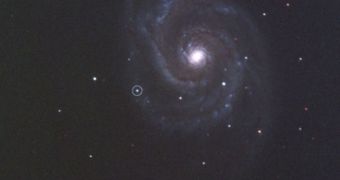The international astronomical community is currently scrambling to analyze an impressive new supernova, that was observed taking place in the nearby galaxy Messier 51, also known as the Whirlpool Galaxy.
The cosmic structure is located in one of the 88 official modern constellations, called Canes Venatici. In the night of May 31, professional and amateur astronomers alike started to detect the first signs of the massive stellar explosion, that no doubt meant the death of a massive star.
The Palomar Transient Factory (PTF) Sky Survey, operated by a 48-inch telescope working in collaboration with the US Department of Energy’s (DOE) National Energy Research Scientific Computing Center (NERSC), was the first to identify the object.
As soon as its location was established to be in one of M51's spiral arms, other teams hurried to image the object as well, collecting data for ulterior analysis. Weizmann Institute's Martin Kraar Observatory and the Wise Observatory of the Tel Aviv University, in Israel, also managed to image the event.
Supernova explosions occur in either of two scenarios. In one, a massive star reaches the end of its burning cycle, and is now longer capable of sustaining nuclear fusion. Its atmosphere is violently ejected into what we perceive as an explosion, and the core collapses in a black hole or neutron star.
In the second scenarios, the event is produced by a white dwarf in a binary system. As the small star accretes mass from its companion star, it eventually becomes so large that it destabilizes, and nuclear fusion is triggered spontaneously.
When this happens, a massive thermonuclear explosion occurs, shedding the excess material from the star. If the accretion process begins anew, then the binary system is cataloged as a relapsing supernova.
The supernova experts saw in M51 is the first one to be detected in the Whirlpool Galaxy since 2005. The cosmic structure is located an estimated 26 million light-years away, which is relatively close in astronomical terms, Daily Galaxy reports.
As light from the new supernova fades, astronomers will continue to observe. Spectral analysis of its light will provide experts with an insight into how the original star looked like, but also into the reasons why it blew up.

 14 DAY TRIAL //
14 DAY TRIAL //